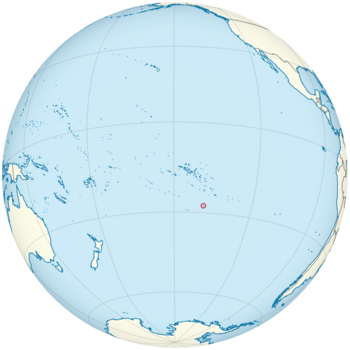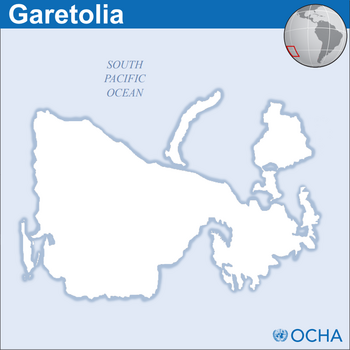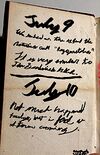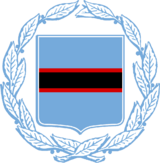Garetolia: Difference between revisions
No edit summary |
No edit summary |
||
| Line 13: | Line 13: | ||
| national_motto = {{nativelang-kt|"A'kē la'ō re'Karātōl'ī"}}<br />{{small|"For Garetolia"}} | | national_motto = {{nativelang-kt|"A'kē la'ō re'Karātōl'ī"}}<br />{{small|"For Garetolia"}} | ||
| royal_anthem = {{wp|God Save the Queen}} | | royal_anthem = {{wp|God Save the Queen}} | ||
| anthem = {{nativelang-kt|''[[Karātōl'ikī Polek'o]]''}}<br/>{{small|(Garetolian Pride)}} <div style="display:inline-block;margin-top:0.4em;">[[File:Karātōl'ikī Polek'o.ogg]]</div> | | anthem = {{nativelang-kt|''[[Karātōl'ikī Polek'o]]''}}<br/>{{small|(Garetolian Pride)}} <br> <div style="display:inline-block;margin-top:0.4em;">[[File:Karātōl'ikī Polek'o.ogg]]</div> | ||
| official_languages = {{wp|English language|English}}<br> [[Garetolian language|Garetolian]] <small>(re'Karātōl'ikī)</small> | | official_languages = {{wp|English language|English}}<br> [[Garetolian language|Garetolian]] <small>(re'Karātōl'ikī)</small> | ||
| regional_languages = [[Kaekian language|Kaekian]] <small>(re'Ka'ekī)</small><br/>{{wp|French language|French}} {{small|(Français)}} | | regional_languages = [[Kaekian language|Kaekian]] <small>(re'Ka'ekī)</small><br/>{{wp|French language|French}} {{small|(Français)}} | ||
Latest revision as of 07:41, 18 August 2024
This article is incomplete because it is pending further input from participants, or it is a work-in-progress by one author. Please comment on this article's talk page to share your input, comments and questions. Note: To contribute to this article, you may need to seek help from the author(s) of this page. |
Republic of Garetolia Repōkalāka re'Karātōl'ī (Garetolian) | |
|---|---|
| Motto: "A'kē la'ō re'Karātōl'ī" (Garetolian) "For Garetolia" | |
| Anthem: Karātōl'ikī Polek'o (Garetolian) (Garetolian Pride) | |
 | |
 | |
| Capital and largest city | Ule'eka Coordinates: |
| Official languages | English Garetolian (re'Karātōl'ikī) |
| Recognised regional languages | Kaekian (re'Ka'ekī) French (Français) |
| Ethnic groups (2016) |
|
| Religion (2007) |
|
| Demonym(s) | Garetolian |
| Government | Parliamentary representative democratic republic |
• Monarch | Charles III |
| Michelle Maris | |
| Michael Stroman | |
| Kolo Laho'ma | |
| Legislature | Parliament |
| Independence | |
• from the United Kingdom | 14 June 1978 |
| Area | |
• Total | 22,559 km2 (8,710 sq mi) (148th) |
• Water (%) | negligible |
| Population | |
• 2020 estimate | 279,000 (161st) |
• 2019 census | 278,532 |
• Density | 12/km2 (31.1/sq mi) (179th) |
| GDP (nominal) | 2020 estimate |
• Total | $274.291 billion |
• Per capita | $962.40 |
| Gini (2019) | low |
| HDI (2019) | high (106th) |
| Currency | Garetolian Dollar (KTD) |
| Time zone | UTC-10 (KTT) |
• Summer (DST) | UTC-9 (KTST) |
| Driving side | left |
| Calling code | +693 |
| ISO 3166 code | KT |
| Internet TLD | .kt |
Garetolia (/ˌɡɛərəˈtoʊliə/ GAIR-ə-TOL-ee-ə; Garetolian: re'Karātōl'ī [reʔkaˌraːˈtoːlʔiː]), officially the Republic of Garetolia (Garetolian: Repōkalāka re'Karātōl'ī [reˌpoːkaˈlaːka]) is an island nation in Polynesia the South Pacific. Its closest neighbors are French Polynesia to the north; the Cook Islands to the northwest; the Pitcairn Islands to the east-northeast; and Easter Island to the far east. Garetolia consists of an archipelago of ten islands and twelve small atolls, amounting to an area of approximately 22,559 square kilometers. The most outlying island is Masa Minor. The four main islands amount to 99% of the total population of over 278,000. The capital, Ule'eka, is the nation's primary shpping port. More than three quarters of the population lives on the largest island, Cona, whereas others mainly live on the island of Mioanhatiin. Due to its terrain, the island of Noviisida is sparsely inhabited.
Garetolia was formed by volcanic activity some 130 million years ago. Geothermal activity is still visible on many of the islands, mostly on Noviisida. Around 500 years ago, the islands were inhabited by Polynesian peoples. Novi'isida, however, was only permanently inhabited as early as 1882 due to its rocky and mountainous terrain. James Cook discovered the island for the British Empire in 1775, where many people settled. However, the first Europeans to land on the island were the crew members of the Portuguese explorer Pedro Fernandes de Queirós in 1767, where they quickly left due to a volcanic eruption.
During colonization, The British started to publicly execute native Garetolians, simply because of their beliefs and ethnicity. This period was known as the Garetolian Genocide, started in 1813. In 1848, the Garetolian people started to fight back against the British, which went on for about 7 months. In 1849, upon royal decree by Queen Victoria, the Brtish ceased these actions. During the 1850s, Garetolia was relatively unknown due to its remote location and small population. During the World Wars, Garetolia fought alongside Britain as well as other colonies such as Australia and New Zealand. In 1978, Garetolia gained its independence.
Since 1987, Garetolia has maintained adequate diplomacy with many French overseas departments such as French Polynesia and Wallis and Futuna, as France was the first nation to recognize Garetolia as a sovereign state. Since its independence, Garetolia has become a member of the United Nations, the Commonwealth of Nations, and the Pacific Islands Forum.
Etymology
Although it is known that the name Garetolia comes from an anglicized corruption of the indigenous word "re'Karātōl'ī", there is some debate as to what the indigenous word actually meant. Some accounts say that the word roughly translates to "the utopia", possibly citing the tropical environment and rich natural resources. Others have proposed that "re'Karātōl'ī" was either an older or colloquial version of the word "rakānol'ī" which means "outsiders". It is possible, though not widely accepted, that the native Garetolians had given the British a false name for the island, and that the native name had been lost to history during the Garetolian Genocide. Nonetheless, the former theory is the most accepted one and is the official etymology on many sites such as the British Library and the CIA World Factbook.
History
Early history
The early history of Garetolia is still somewhat unknown; however, archaeological evidence strongly supports the theory that Garetolia was first inhabited by Māori Polynesians, as their remains can still be found today on Filan. According to oral tradition, native Garetolians were supposedly the descendants of the legendary tribe leader Mak'ale'o, and were sent to the island by God. Mak'ale'o, however, may not have even existed, and due to the obvious debate on the existence of God himself, such theories have been called into question. Many experts support the theory that Garetolia was once a single island, and has over time due to climate change slowly sunk into the ocean. The latter theory has been deemed by scientists to be the more likely one.

Pottery from around 4500 years ago shows that Austronesians settled the island from 3000 to 2000 BC, with Melanesians coming some 1100 years after. Evidence shows that some settlers may have come from Fiji or Tonga. In the mid-1700s, Garetolia experienced an influx of settlers from the Tu'i Tonga Empire, which greatly changed the percentage of Garetolians over the next few decades.
First European contact
Portugal
In 1767, Portuguese explorer Fernandes de Queirós first came in contact with the islanders. He and his 12 men settled there for about two months, forming the Colony of New Madeira (Portuguese: Colônia da Nova Madeira). During this time however, the natives had little knowledge of their presence. However, a volcanic eruption on the island of Novi'isida, on which they were staying, forced them to evacuate. During his stay, the islanders seldom came in contact with the Europeans, which is why the Portuguese never knew about their languages.
Great Britain and James Cook
In 1776, James Cook of Great Britain found the island for the British. He and his other nearly 100 men stayed for 3 months and founded the Colony of Raygaretolia, later renaming to New Anglesey. They almost always came into contact and discovered that the islanders had their own languages, cultures, and customs. James Cook distinctly noted that the islanders had traditions similar to those of the Sentinelese. One of his men, Joseph Franklin, was sacrificed by the islanders, which led Cook to believe that the islanders also had distinct religions. In his diary, Cook described the islanders as "a peculiar mix of lovely and brute". Later in the year, Cook and some other members of his crew left the island to further their expedition, where about 30 men stayed behind to discover more. In July 1777, Thomas C. Ule, who is believed to have written the above entry into his diary and worked on the ship with James Cook, went down to the beach one late afternoon with one of his shipmates, where they then discovered an indigenous Ka'ekian ritual being performed. Some ancient Ka'ekian legends say that any outsiders that witness traditions will have "prompt consequences coming to them". 3 days later, Ule, as well as several other settlers, were ambushed by a band of Ka'ekians during their communal luncheon. Later that year, a passenger ship sailed by and discovered the remains, and also found some starving settlers from the previous group. This sparked a decades-long controversy between the British settlers and the native Garetolians. Eighteen years later, in 1795, George III declared the establishment of the Dominion of Garetolia, which lasted until Garetolia's independence in 1978.
Garetolian Genocide
From 1813 to 1849, the British-controlled government began publicly executing Garetolians and Ka'ekians because of their religions and culture. After the ambush on Thomas Ule and his men, many British settlers were aggravated by the indigenous customs of human sacrifice and bonfires, referring to them as "inhumane atrocities", according to some accounts. Shortly after the Dominion of Garetolia was established, much hate and discrimination perpetrated by the British colonisers gradually curbed the growth of the Garetolian population. In 1809, 167 Garetolian tribespeople were brutally killed in the Komo Tragedy of 1809. Only a few years later, Governor of the Dominion of Garetolia Steven Fairchild ordered the execution of Garetolians and Ka'ekians that did not "assimilate with the status quo". While some Garetolians, rather unwillingly, became ones with the British, most of the native islanders refused and were forced to either hide or commit suicide in order to avoid being persecuted by the British. In the first five years, over 500 Garetolians were publicly executed. This number, however, almost quadrupled by 1825. By then, almost 1,800 natives had been killed. According to the first national censuses in 1819 and 1829, Ka'ekians had also not been spared. Along with these records, a separate study in 2016 by the Garetolian Historical Agency concluded that around 700 Ka'ekians had been executed before the government deemed the Ka'ekians "not worthy of punishment due to their lack of knowledge". By the 1830s, it is estimated that almost 3,000 Garetolians had been executed, and by this time, foreign nations such as the United States, Spain, and many German immigrants in Garetolia criticized and condemned the actions taken by the British. In 1849, Queen Victoria ordered the discontinuation of this practice, thus ending the Garetolian Genocide. In the years shortly after, Garetolia experienced a population boom amongst the native Garetolians and Ka'ekians, that had negated the near 4,200 deaths caused by the British. The cause of this population boom is still unknown, although most historical accounts cite that the Garetolians wanted to reverse the effect of the Garetolian Genocide and outnumber the British.
Late 1800s and 1900s
During the 1860s, the first official flag of the Dominion of Garetolia was created. It contained the Union flag in the canton and the seal of the Dominion in the fly side. In 1872, the governorship of Garetolia had been launched into a frenzy when then-current governor, Mitchell Peckham, died while in office. Normally, an exchange of power would come after either the resignation of the governor or the replacement of the governor by the monarch. Since no law had specified what would happen if the governor had died in office, many sides to the issue arose. Most ethnic Garetolians and Ka'ekians wanted the governor to be elected, much like a president; others insisted that the monarch should have their say on who becomes the next governor. Some, mostly radical monarchists, advocated that the title of Governor should fall to the governor's oldest son, Marcus Peckham, who happened to be imprisoned at the time. Nevertheless, Queen Victoria ignored the sides of the issue and simply appointed William Morganfield as the new Governor.
In 1874, educator John Hallmark discovered the island of Filan, during a fishing trip with his son. This discovery caused many to settle and come into contact with the native Filanian Garetolians. This, in turn, caused the Filanians to be expelled from the island by the settlers from the other islands, sparking the Hes'iki Controversy of 1875. As most of the Filanians left to the Samoan Islands, what some consider as the Second Garetolian Genocide began, in that many of the remaining Filanians were either killed or forced into labour. Due to these actions taken by the settlers in Filan, ethnic Garetolians and Ka'ekians began advocating for the Independence of Garetolia, which started with small protests in Dali'eka, then known as Stuartville. These protests gained attention across the Dominion, first spreading to Lod'oka (then known as Kimberley), Ure'naka (then known as Gainesville), and ultimately, Ule'eka. Despite these protests, the Governors of Garetolia denied rights to autonomy. In 1903, Thomas Rennel was appointed as governor, and although he promised to stop the protests entirely, the execution did not work and as a result, the independence movement only gained more support. Internationally, the struggle was seldom addressed, as the movements had little organised support and since the British were already allied with many nations around the world. However, noticeable support gathered in Chile, where the president at that time, Germán Riesco Errázuriz, pointed out the similarities between the independence movement of Chile from the Spanish and Garetolia from the British.
World Wars
As a crown colony, Garetolia fought in World War I alongside the United Kingdom in the Entente. Except for an airstrike by the German Empire, there was vitually no action in Garetolia. However, in Europe, 22 Garetolians were killed in action in Bulgaria.
Before World War II, Garetolia was gradually demilitarised as a result of growing opposition to war; however, as the threat of Nazi Germany grew in Europe, the United Kingdom had no choice but to reestablish Garetolia as an overseas military base, specifcally Ule'eka Airport. Because of the small amount of Garetolians willing to fight, a draft was almost immediately put into place, causing almost 6,000 Garetolians to be sent into war, leaving only about 2,300 to return. In September of 1943, Garetolia was subject to several airstrikes and bombings, mainly Ule'eka. When the war ended, no official announcement was made by the Governor, leaving thousands of Garetolians to believe the war was still going on until 1947. This fact is known colloquially as World War II's Epilogue.
Decolonisation
The formation of the United Nations after World War II resulted in the United Nations Special Committee on Decolonization committing to a process of decolonisation; as a consequence, the British colonies in the Pacific started on a path to self-determination.
In 1951, an explosion at an office building in Ule'eka left 84 dead and four injured. Reports say that the explosion was perpetrated by Kolo Makan'o, a Garetolian nationalist, as an attack on the British. 14 years later, in 1965, nearly a fifth of the Admiralty House was burned by Garetolian nationalists in an attempt to kill the Governor. At this time, the independence movement was headed by Kano Molok'a, who condemned the attacks. That same year, about a month later, the aforementioned Gainesville experienced protests which quickly devolved into riots. The Gainesville Riots of 1965 marked the first violent protests of the Garetolian Independence Movement, leaving 12 dead and many more injured. Shortly after these protests subsided, a joint statement made by the Governor of the Dominion of Garetolia, Leonard Coleman, and Queen Elizabeth condemned the actions and urged the Garetolians to cease the actions committed during the riots.
Independence
In March of 1968, Garetolia established a de facto government, and declared its independence in June of 1978. In July, France officially recognized Garetolia as a sovereign state, followed by Ireland in August, Spain and Portugal in September, and the United States in December. On 19 February 1979, Garetolia finally was admitted to the United Nations, with the approval of the UK itself, forced under pressure by China and the Soviet Union, who had voted to recognize Garetolia a mere three hours earlier. Upon the admission, Garetolia became the 148th member state of the United Nations.
Modern era
Recently, Garetolia has been ranked high on the Democracy index, and has been noted to have low wealth inqeuality. Garetolia is currently run by Prime Minister Michael Stroman, elected in October 2021, and Governor-General Michelle Maris. The Covid-19 pandemic in Garetolia forced former prime minister George Kennel to officially close all borders in order to contain the virus. In January of 2022, the eruption of Hunga Tonga–Hunga Ha'apai in Tonga caused waves as high as 7 metres (23 feet) to be recorded in Flian and Novi'isida. In June 2022, the Garetolia national football team qualified for the World Cup in November. In Spetember of the same year, Garetolia observed the succession of Charles III to the throne of the United Kingdom. In honor of the death of Elizabeth II, Stroman announced that all flags at government buildings be flown at half staff.
Geography
Climate
Government



